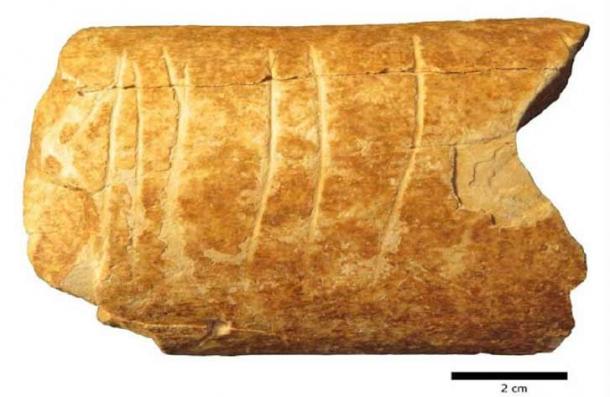Researchers have uncovered what they claim is among the earliest-known use of symbols “ever discovered.” The collection of lines carved into a bone fragment date to approximately 120,000 years ago, but as you will see, they are but children compared to the antiquity of the grandfather of all ancient symbols.
The discovery and analysis of “six similar etchings on one side of a bone fragment” was made by a team of archaeologists from the Hebrew University of Jerusalem and the University of Haifa, with researchers from the Centre National de la Recherche Scientifique in France. The new research was published in the scientific journal Quaternary International in which the team concluded that the mysterious 120,000-year-old bone “held symbolic or spiritual significance”.
Analyzing What Appear To Be 120,000-Year-Old Hunting Symbols
In an article reposted on Archaeology News Network , Dr. Yossi Zaidner, of the Institute of Archeology at the Hebrew University of Jerusalem says that the discovery site in the Ramle (also Ramla) region of central Israel was “likely used as a camp or a meeting place for Paleolithic hunters who would then slaughter the animals they caught at that location.”
The team’s analysis of the bone fragment led them to believe that it belonged to a now extinct large species of wild cattle , a species which the researchers noted was common in the Middle East at that time (120,000 years ago).
Dr. Iris Groman-Yaroslavski from the University of Haifa explained in the paper that laboratory analysis and high-resolution 3D scans revealed microscopic elements that determined the marks on the bone were no accident, rather, that they were made deliberately with “a sharp tool fashioned from flint rock.” And reassuring any skeptics out there that the lines are indeed “symbols” and actually deliberate, the authors wrote that “the engravings were definitely intentionally man made and could not have been the result of animal butchering activities or natural processes over the millennia.”

The cleaned-up bone fragment found in Ramla, Israel, clearly showing the six manmade “line” symbols carved into it. (Marion Prévost / Hebrew University of Jerusalem )
Ancient Animal Status Symbols?
Big claims require big evidence. Right? The team of researchers noticed that the carved grooves on the bone fragment “are in a clear U-shape and wide and deep enough that they could not have been made by anything other than humans intent on carving lines into the bone.” Furthermore, by analyzing the microscopic edges of the grooves the team were able to conclude that the prehistoric work was performed “by a right-handed craftsman.” What’s more, the scientists also figured out that the maker had completed the lines in a single effort.
Ms. Marion Prévost, from the Institute of Archeology at the Hebrew University of Jerusalem, says every indication suggests “there was a definite message behind what was carved into the bone.” So, if 120,000-years-ago someone created a “symbol,” what was the underlying message behind the six carved lines?
The authors “hypothesize” that the particular bone choice related to “the status of that animal in that hunting community and is indicative of the spiritual connection that the hunters had with the animals they killed.” The team also said the “engraving” is very likely an example of “ symbolic activity” and as such it represents what Dr. Zaidner said, is “one of the oldest symbolic engravings ever found on Earth.”

This etched shell from Java is considered to be the oldest symbolic engraving, dating back about 500,000 years! (Wim Lustenhouwer / VU University Amsterdam )
Calm Down Professor: That’s A Bit Much!
This bone fragment is one of the “oldest carved symbols ever discovered,” however, it is no match with the shell dug up in Trinil, Indonesia, in the 1890s by Dutch geologist Eugene Dubois. This clamshell featuring a zig-zag pattern was described in a 2014 New Scientist article as “by far the oldest engraving ever found.” What’s more, the team of scientists behind the study of the clamshell published a paper in Nature saying “it challenges what we know about the origin of art and complex human thought.”
Sediment inside the shell and microscopic grains pulled from the zig-zag pattern were dated revealing the shell had been buried “between 430,000 and 540,000 years ago.” Some “right-handed” ancient hominin sat on the banks of a river in central Java and with “a remarkably steady hand and a strong arm” used a shark ’s tooth to score “a deep, purposeful and tidy zigzag pattern” into the clam shell. And this occurred some two to three hundred thousand years before our own species evolved.
While the discovery of the 120,000-year-old bone fragment with its six symbolic lines is unarguably “rare,” it was made yesterday compared with the deeply ancient heritage of the undisputed “most ancient symbol” on Earth: the Indonesian zig-zag shell.
Top image: The bone fragment found in Ramla, Israel with lines or symbols carved into it, as it was found in situ. Source: Marion Prévost / Hebrew University of Jerusalem
By Ashley Cowie
 RSS Feed
RSS Feed















 February 5th, 2021
February 5th, 2021  Awake Goy
Awake Goy  Posted in
Posted in  Tags:
Tags: 













